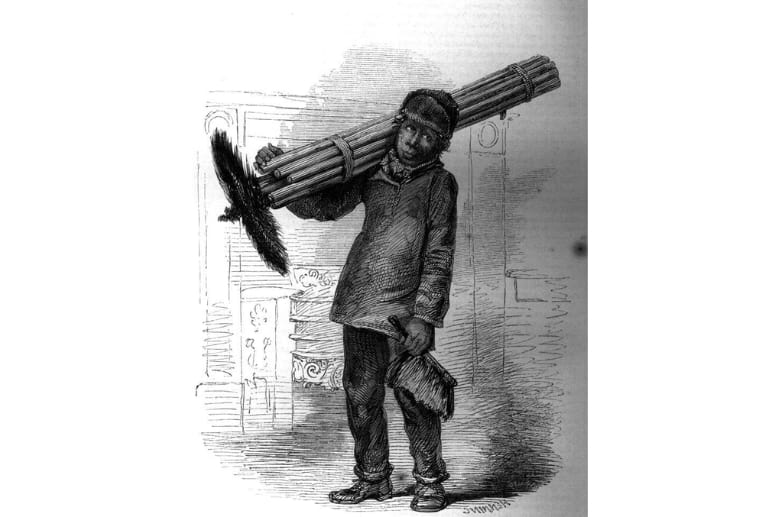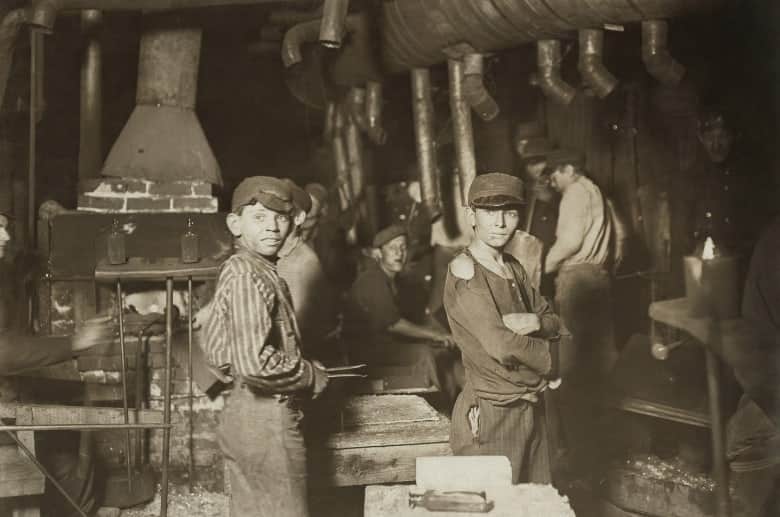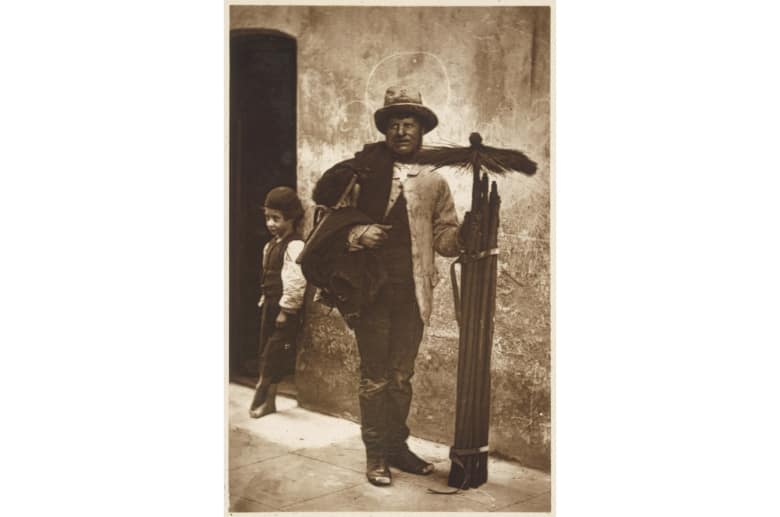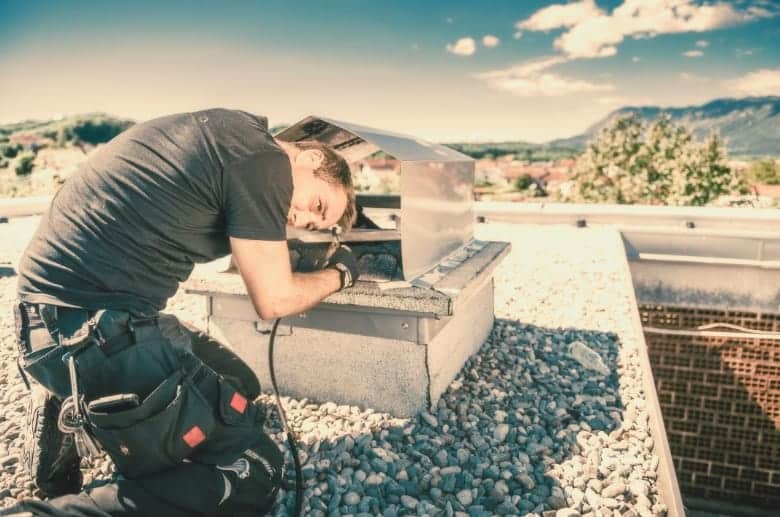Ah, the chimney sweep history! Is there anything more mysterious than the soot-covered men of old scaling buildings while donned in top hats and tails? A profession with a long and storied past, the chimney sweeping business is full of secrets yet to be unraveled.
An important part of the Western world since the Middle Ages, these professional contractors are experts at caring for the hearth of the home. Let’s dive into why chimney sweeps were seen as symbols of good luck and prosperity – and take a look at how we have come to depend on them even today.
Early History of Chimney Sweeps
The history of the chimney sweep dates back to at least the 13th century, but it was in the 16th century in England that fireplaces and chimneys became commonplace. Fireplaces heated buildings and homes, offering a less smoky alternative to open fires, providing safer air and better health for all in the home.
Coal was the primary fuel used in these early fireplaces. It left behind sooty residue and coal deposits that had to be routinely removed. This grimy task was the responsibility of skilled laborers called ‘chimney sweeps’ who cleaned the flues inside chimneys to keep families safe and warm.
But how did this profession start, and who were these men scaling buildings in olden times?
Climbing Boy: A Darker Chapter in Chimney Sweep History

You might think back to the magical time of Mary Poppins and Bert the Chimney Sweep, but these men had a far more grim though important job. To keep up with the demand for fireplaces, climbing boys – often orphans or those purchased by distressed parents – were the apprentices to the chimney master.
Forced to enter the harrowing, dark confines of chimney flues in search of grime and soot deposits, child chimney sweeps – usually between 5 and 11 years old – would scamper up and down the narrow passages. Their bodies were small enough to allow them passage into tight spaces.
Most times, it wouldn’t take more than a fire or threatening bundle of straw to have reluctant children entering the dwindling space. The problem with this practice? As you can probably guess, these boys often fell, broke bones, and developed various diseases from soot inhalation, including respiratory problems and cancer. Despicable!
Their tools in that age were primitive as well. While today there are more efficient tools for the job, back then, metal scrapers were used to tackle the stubborn tar deposits. To help the master sweep, these young boys often had to go without proper clothing and protection, leaving them susceptible to disease and often, death.
——
Do You Need to Hire Chimney & Fireplace Expert?
Get free quotes from qualified experts near you. No commitment required!
——
The Life of a Chimney Sweep: 1800s and 1900s
In early times, chimney sweeping was mostly a family-run business, employing boys and girls from the wider family for an apprenticeship. As work became more sought after due to increased demand during the industrialization of large cities and a growing population, more production-centric factories grew in popularity. Dedicated chimney sweeping services became a broader company endeavor, though the family-run team was still the prevalent service.
The grimy occupation of chimney sweeping was dangerous but a reality for poor children with no other way to make a living. That was the case until September 1875, when the public realized something had to change. At this time, Parliament established a bill prohibiting children’s use as chimney sweeps – beginning with deterrents like large penalty fees.
Sneaking away from their masters, these kids often unknowingly took part in illegal activity, culminating in a tumultuous life ranging from sleeping in basements on soot-stained furniture to dealing with long hours and deadly tunnels of flues.
Chimney Sweepers: Industrial Revolution

While new laws and regulations improved the conditions of those employed within the industry, it was only a short time until sweeping tools did as well. Engineer Joseph Glass, for instance, came up with a rope system of canes and brushes that stuck and pushed up from the firing platform. Later in Great Britain, chimney sweepers crafted their versions using malacca timber (an East Indian type) and whalebone to brush off the flue walls.
In addition, some adopted the ball-brush-rope method imported from Europe. A weight of iron or lead was used to drag the brush down while the sweeping happened simultaneously. These materials and products made life much easier for the chimney sweeper.
At the turn of the 19th century, coal, seasoned wood, or other fossil fuels were needed less often due to gas becoming more common for home heating (followed by a resurgence leading up to the 1970s).
Modern chimney sweepers don’t have it any easier – despite technological advances involving cameras, scanners, and computers. Gusty winds and uncomfortable positions still threaten the safety of these hard-working men and women as they descend the perils of what often resembles a blackened maze.
The Role Of Chimney Sweeps in Literature and Culture
You can’t talk about chimney sweepers without discussing their cultural fascination. From Roald Dahl’s wonderfully dark The Witches to Mary Poppins’ bubbly Bert, the superstition surrounding these sooty-faced men was somewhat supernatural.
Top Hat and Tails

Although the origin of the top hat and tails is open to interpretation, one legend has it that early sweeps were gifted this ceremonial uniform after saving King George’s horse from a runaway cart. As the story goes, these garments would have been expensive, so a practical person of working class status might not otherwise have access to them.
Another story suggests that chimney sweeps began wearing the cast-off garments of funeral directors.
In any case, smartly-dressed master sweeps became a token of good luck – seen at weddings in some cities even today. It’s quite interesting, given that their jobs have often been depicted in a negative light.
A Symbol of Good Fortune
It’s clear why early Londoners and some living abroad held these honorable servants in such high regard. Their courage in smokey abysses honored morals, and although their routes were filled with darkness, they often saved the day. They were the front-line defense against fire and smoke inhalation while ensuring that the heating source kept homeowners and their families warm and safe during the harshest winters.
Mary Poppins had it right when she said, “A sweep is as lucky as lucky can be.” And today, chimney sweeps continue to be a source of luck for many people, families, and buildings. After all, they still play an important role in keeping us safe and warm – with luck to spare.
Evolution of Chimney Sweeping Practices and Techniques
It’s undeniable that the chimney sweep has come a long way since its humble beginnings. Initial practices involved using manual brushes and various other crude devices to scrape away soot build-up from inside the chimney. Though their standards were high, the operation was difficult.
However, with technological advances came better tools and improved techniques that enabled a more effective and efficient job.
Today’s professional sweepers leverage the old and new combination, from strong but lightweight chimney brushes to industrial vacuum cleaners. High-tech cameras and scopes also help to get a good look at those hard-to-reach parts, allowing for early detection of structural damage.
Since the traditional job of the chimney sweeper was so laborious and involved such risks, we’re thankful that they no longer have to climb up buildings in top hats and tails.
Modern Chimney Sweeping Today

The times of poor treatment of children and the necessity of climbing into danger have changed. Today, an apprentice or journeyman sweep are no longer young children putting themselves in harm’s way; they are professionals who choose to make chimney and fireplace work their lifelong career.
Those chimney sweeps of yesteryear, with all their troubles and traumas, have now thankfully been relegated to history books. Today’s chimney sweeps are better educated in the science of fireplaces and chimneys. With that comes better safety equipment, improved techniques, and more effective tools.
For homeowners wondering what is included in a chimney sweep, it’s a comprehensive service that includes inspection, removal of soot and creosote, and ensuring the chimney’s structural integrity. From diagnostic electronics to video cameras to brush and vacuum systems – chimney sweeps have come a long way since their inception.
Today’s chimney sweeps work in safer areas, often as a team, and give customers the powerful result they expect from a solid chimney cleaning without going through the dangers it takes to keep others safe.
The world of chimney watchfulness has come a long way regarding safety, quality, and invention – leaving us with professional chimney sweeps that don’t need to risk their lives scouring through the flue while warding off carbon monoxide poisonings and house fires.
But the importance of chimney cleaning and maintenance remains the same, as does the fact that we need reliable chimney sweepers to keep us safe and warm. The old myth of sweeps in top hats stealing young children has been replaced by a new era of healthy, informed professionals who put safety first.
——
Do You Need to Hire Chimney & Fireplace Expert?
Get free quotes from qualified experts near you. No commitment required!
——
The Importance of Chimney Maintenance and Inspection
We’ve explored the long history of chimney sweeps dating back centuries, and we know how much they’ve changed over time, but why are they still so essential in modern life? They are just as required today as they were during the 18th century!
Although laws protecting those employed in the chimney sweeping profession have improved drastically, many overlook the importance of regularly cleaning and inspecting their chimneys. Some homeowners might be tempted to take a DIY chimney sweep approach, but it’s crucial to understand that without the proper knowledge and tools, this can be risky.
This is a fundamental part of keeping the fireplace safe and efficient from both a fire safety and energy efficiency perspective.
Without proper maintenance, chimneys can become blocked with debris such as leaves and branches, allowing hazardous fumes such as carbon monoxide and sooty, flammable substances like creosote to build up. This can lead to severe safety risks from gas explosions and related accidents or illnesses in the home.
Chimney inspections, when done correctly and regularly, can help to minimize these risks as well as catch any chimney structural problems early on. This prevents bigger issues down the line that could lead to costly repairs.
A Lucky Profession
The history of chimney sweep businesses is rich, marked by tragedy and triumph.
We’ve seen how they’ve evolved with technological advancements and better safety regulations, establishing their place as essential professionals in the home heating industry and saving families from life-threatening fires and other disasters. But more than that, they’ve become symbols of good luck – a symbol of hope and prosperity.
But this luck can only be had with regular inspections and maintenance – tasks that a homeowner should leave to certified chimney professionals trained and experienced in chimney care.
So to truly benefit from the luck that comes with a chimney sweeper, stay safe and make sure yours is up-to-date with the times!






